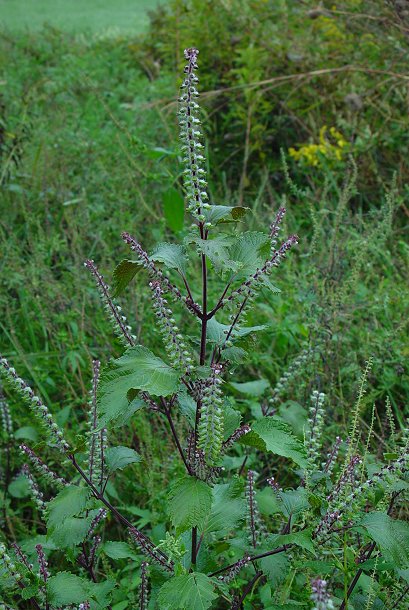Perilla frutescens (L.) Britton
Beefsteak Plant

Introduced
CC = *
CW = 0
MOC = 58
© DETenaglia
Perilla frutescens (L.) BrittonBeefsteak Plant | |
 |
Introduced CC = * CW = 0 MOC = 58 |
© DETenaglia |
|
Family - Lamiaceae Habit - Taprooted annual forb, aromatic with a characteristic odor. Stems - Ascending to erect, to 80 cm, 4-angled, with a single median vertical groove on each side of the stem, branched, sparsely to moderately pubescent with loosely downward-curved, multicellular hairs, more densely so toward the tip and around the nodes, often nearly glabrous toward the base, sometimes strongly purplish-tinged.
Leaves - Opposite, mostly long-petiolate, decussate. Petioles to 5 cm long, antrorse-pubescent, purple, with a very shallow adaxial groove. Blades 3-15 cm long, sometimes largely or entirely dark brownish purple, oblong-ovate to broadly ovate or occasionally broadly elliptic, unlobed, sometimes crisped, the margins coarsely toothed, broadly angled to angled or short-tapered at the base, angled or tapered to a sharply pointed tip, the surfaces glabrous or more commonly sparsely short-hairy, mostly along the veins, the undersurface also with conspicuous sessile glands. Lateral veins prominently expressed below.
Inflorescences - Terminal and axillary, dense, slender, usually elongate spikelike racemes, the flowers 2 per node, these short-stalked, the stalks 1-2 mm long in flower, pubescent and glandular. Bracts 3-6 mm long, not extending past the calyces, elliptic to ovate, sharply pointed. Axis retrorsely pubescent, the hairs purple.
Flowers - Calyces 2-3 mm long at flowering, zygomorphic, symmetric at the base at flowering, more or less bell-shaped, the tube 10-nerved, the nerves obscured by usually dense, spreading, multicellular hairs on the outer surface, sparsely hairy in the mouth, the lips slightly shorter than to slightly longer than the tube, the upper lip curved slightly upward, with 3 triangular lobes, the lower lip slightly curved upward, with 2 deeper, narrowly triangular lobes, the lobes all tapered to sharply pointed tips, usually with relatively dense, sessile glands and sometimes with a few spreading, nonglandular hairs toward the base on the outer surface, becoming enlarged to 8-12 mm, papery, and swollen or pouched basally on the lower side at fruiting. Corollas 2.5-4.0 mm long, nearly actinomorphic, not 2-lipped, white to pale purple, lacking darker purple spots, the outer surface glabrous or more commonly sparsely hairy, bell-shaped, the tube hairy in the throat, the 5 lobes very short, all similar, broadly rounded to bluntly pointed, somewhat spreading. Stamens 4, short-exserted, the 2 pairs equal or nearly so, the anthers small, the connective short, the pollen sacs 2, spreading, dark purple. Ovary deeply lobed, the style appearing more or less basal from a deep apical notch. Style short-exserted, with 2 unequal branches at the tip.
Fruits - Dry schizocarps separating into 2-4 nutlets, these 1.3-2.0 mm long, more or less globose, rounded at the tip, the surface orangish brown to reddish brown, with a network of fine nerves or slender, low ridges, glabrous.
Flowering - June - October. Habitat - Bottomland forests, streambanks, bases of bluffs, fens, seeps, fields, pastures, cemeteries, railroads, roadsides, moist disturbed areas. Origin - Native to Asia. Lookalikes - When flowering, none. Other info. - This weedy species can be found predominantly in the southern 2/3 of Missouri, and also across most of the southeastern quadrant of the continental U.S. It is very easy to identify, especially while in flower, as no other plant looks or smells quite like it. The purple stems and distinctive leaves are good characters for identification. The leaves of some plants can be crisped, others are flat. Both types of plants can grow right next to each other and are, at most, phases of the species. Two varieties have been named in the U.S.: var. frutescens, which has coarsely toothed leaf margins, and var. crispa, which has leaf margins which are more finely toothed and sometimes crisped.
Perilla frutescens has a long history of use as a food, medicine, and source of dye. Oil expressed from the seeds, called "perilla oil," has been used in manufacture of lacquer, artificial leather, paper umbrellas, printer's ink, and waterproof clothing, and as an inexpensive substitute for linseed oil. Asian cuisines have utilized the plant in cooking or as a garnish, sometimes under the common name "shiso." In fact, the species was probably brought deliberately to this continent by migrating Asian people seeking to retain use of their herbs. Some caution is advised, as the plant's secondary chemistry is extensive and includes many toxic compounds. Livestock which graze heavily upon the plant can develop a syndrome called "panting sickness," which can lead to acute respiratory distress and death. Overuse in humans can result in the same symptoms. As properly stated by Yatskievych, "...dosage is the key to distinguishing between a pleasant food flavorant and a toxic plant." Unfortunately, in parts of the U.S. the plant behaves aggressively and can form extensive weedy populations. Photographs taken in the Ozark Scenic Riverways, Shannon County, MO., 9-20-03 (DETenaglia); also along Fox Creek, St. Louis County, MO, 9-2-2020, and along the Katy Trail near Treloar, Warren County, MO, 10-6-2020 (SRTurner). |